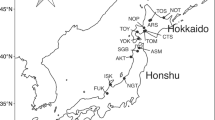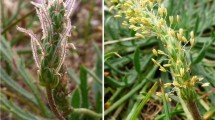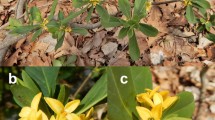Abstract
Mating systems and seed reproduction in gynodioecious Geranium asiaticum Serg. (G. bifolium Patrin.) were studied in four coenopopulations of Western Siberia (Novosibirsk region). The bisexual flower of hermaphrodite individuals of G. asiaticum is characterized by a longer flowering (2.5–3.5 days) than the pistillate flower of female individuals (2–2.5 days), due to the passage of the male (staminate) phase at the beginning of morphogenesis: G. asiaticum is characterized by strict protandry. Mating of individuals of G. asiaticum occurs according to the type of xenogamy, autogamy is completely excluded. In an experiment to isolate individual flowers, 100% of isolated pistillate and bisexual flowers dried up without fertilization. In an experiment on artificial pollination of flowers, 85% (17 out of 20 flowers) of pistillate flowers formed fruits, whereas only 10% (3 out of 30 flowers) of bisexual flowers formed fruits. There were no significant differences in the number of flowers on the generative shoot in female and hermaphrodite individuals. Significant differences were found between heterosexual individuals in terms of the number of fruits and the number of seeds per generative shoot: female individuals formed 16.1–22.1 times more fruits and 13.8–28.3 times more seeds than hermaphrodites. Pistillate flowers formed an average of 1.85 ± 0.08 seeds per flower, and bisexual flowers 0.07 ± 0.02 seeds per flower, i.e., on average, female plants form 26.4 times more seeds than hermaphrodites. It was found that the fruits and seeds were formed mainly by female individuals, but hermaphrodite individuals produced the pollen necessary for fertilization. The different degree of sexual differentiation of G. asiaticum and Geranium sylvaticum L. suggests that in genus Geranium there are transformations in direction of the formation of dioecy.

Similar content being viewed by others
REFERENCES
Abdusalam, A., Tan, D., and Chang, S.M., Sexual expression and reproductive output in the ephemeral Geranium transversale are correlated with environmental conditions, Am. J. Bot., 2017, vol. 104, no. 12, pp. 1920–1929.
Asikainen, E. and Mutikainen, P., Female frequency and relative fitness of females and hermaphrodites in gynodioecious Geranium sylvaticum (Geraniaceae), Am. J. Bot., 2003, vol. 90, no. 2, pp. 226–234. https://doi.org/10.3732/ajb.90.2.226
Bernasconi, G., Antonovics, J., Biere, A., Charlesworth, D., Delph, L.F., Filatov, D., Giraud, T., Hood, M.E., Marais, GAB, McCauley, D., Pannell, J.R., Shykoff, J.A., Vyskot, B., Wolfe, L.M., and Widmer, A., Silene as a model system in ecology and evolution, Heredity, 2009, vol. 103, no. 1, pp. 5–14.
Charlesworth, D., Evolution of plant breeding systems, Curr. Biol., 2006, vol. 16, no. 17, pp. R726–R735.
Dem’yanova, E.I., Distribution of gynodioecy in flowering plants, Bot. Zh., 1985, vol. 70, no. 10, pp. 1289–1301.
Dem‘yanova, E.I., Antekologiya: ucheb. posobie po spetskursu (Antecology: A Textbook for a Special Course), Perm: Perm. Gos. Univ., 2010.
Dem’yanova, E.I. and Ponomarev, A.N., The sex structure of natural populations gynodioecious and dioecious plants of forest-steppe of Zauralye, Bot. Zh., 1979, vol. 64, no. 7, pp. 1017–1024.
Desfeux, C., Maurice, S., Henry, J.P., Lejeune, B., and Gouyon, P.H., Evolution of reproductive systems in the genus Silene, Proc. R. Soc. London, Ser. B, 1996, vol. 263, no. 1369, pp. 409–414.
Gordeeva, N.I., Gynodioecy of the Geranium bifolium (Geraniaceae), Bot. Zh., 2020, vol. 105, no. 3, pp. 86–92. https://doi.org/10.31857/S0006813620030035
Knuth, P., Handbuch der Blutenbiologie, Leipzig, 1898, Bd. II, vol. I, pp. 228–238.
Peshkova, G.A. and Ovchinnikova, S.V., Family Geraniaceae Juss, in Konspekt flory Aziatskoi Rossii: sosudistye rasteniya (Conspectus Florae Rossiae Asiaticae: Plantae Vasculares), Novosibirsk: Sib. Otd. Ross. Akad. Nauk, 2012, pp. 264–267.
Peshkova, G.A., Family Geraniaceae, in Flora Sibiri (Flora Siberiae), Novosibirsk: Nauka, 1996, vol. 10, pp. 8–22.
Ponomarev, A.N., Study of flowering and pollination of plants, in Polevaya geobotanika (Field Geobotany), Moscow: Akad. Nauk SSSR, 1960, vol. 2, pp. 9–19.
Troshkina, V.I., The synopsys of the genus Geranium (Geraniaceae) of the Altai mountain country, Rast. Mir Aziat. Ross., 2019, vol. 3, no. 35, pp. 13–28. https://doi.org/10.21782/RMAR1995-2449-2019-3(13-28)
Zaitsev, G.N., Matematicheskii analiz biologicheskikh dannykh (Mathematical Analysis of the Biological Data), Moscow, 1991.
Funding
The work was carried out within the framework of the State Assignment of Central Siberian Botanical Garden, Siberian Branch of the Russian Academy of Sciences, no. AAAA-A21-121011290026-9.
Author information
Authors and Affiliations
Corresponding author
Ethics declarations
Conflict of interests. The author declares that she has no conflict of interest.
This article does not contain any studies involving animals or human participants.
Additional information
Translated by D. Timchenko
Rights and permissions
About this article
Cite this article
Gordeeva, N.I. Mating Systems and Seed Reproduction in Gynodioecious Geranium asiaticum (Geraniaceae). Dokl Biol Sci 506, 179–183 (2022). https://doi.org/10.1134/S0012496622050039
Received:
Revised:
Accepted:
Published:
Issue Date:
DOI: https://doi.org/10.1134/S0012496622050039




